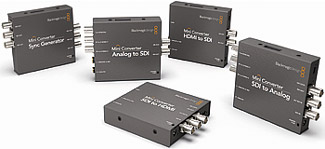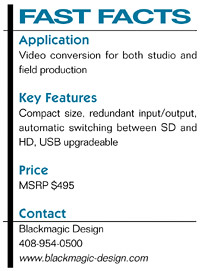Blackmagic Design Mini Converters

Blackmagic Design's series of Mini Converters Ever wished for a standards converter that was small enough for field work, big in features, yet kind to your budget? Blackmagic Design has granted that wish with their series of Mini Converters. Now you can convert analog to SDI, HDMI to SDI and vice versa in the field without having to deal with oversized and overpriced units.
FEATURES
There are four standards converters available: SDI-to-analog, analog-to-SDI, HDMI-to-SDI and SDI-to-HDMI. The units provide two outputs, with more available if devices are piggy-backed. This piggy-backing ability could come in handy in tight spots where "just one more" SDI output is needed. As most DTV operations keep growing, it's easy to use up all those outputs. Compared to rack-mounted converters, the Mini Converters can be a problem solver for a fraction of the space and the expense. And in today's tight economy, being able to pay only for what I need right now is good business.
The Mini Converters can actually be thought of as basic building blocks for applications where different video and audio formats complicate the system design inside the control room or out in the field. There are loopthrough SDI outputs that can be used to connect to another Mini Converter if more de-embedded audio channels or other signals are needed, or if you just want to take advantage of their re-clocking.
One thing that's really attractive is the ability of the Mini Converters to automatically sense SD or HD. This translates to no worries later on if I should decide to upgrade to HD.
There are other things too that set the Mini Converter devices apart from the pack. One of these is their redundant SDI input, which serves as a safety net should the main input fail unexpectedly. Should there be a loss of primary signal, the Mini Converter automatically switches to the backup SDI input in a failsafe fashion. This means less worry when doing field work if a cable is inadvertently disconnected.
Another positive feature is the use of the standard 1/4-inch jack connection for balanced audio or AES/EBU digital audio, with DIP-switch selection. No customized cables are needed to mate with anything in the field.
IN USE
The first thing I noticed when I opened the Mini Converter shipping container was the inclusion of five different AC plugs that would make the Mini Converter useable in just about any country I might visit. The company even thought to mold a slot into the DC plug for keeping it in place with a tie wrap—this could be real lifesaver on remotes. This may appear to be a seemingly insignificant and non-electronic feature, but it speaks volumes about the product designers. Turning the unit around, I found more evidence of thoughtful engineering design. There's a printed guide on the back that shows how to set the DIP switches for different outputs or settings. There is no need to look for the manual or operating instructions, as the guide is printed right onto the chassis.
When I saw the USB connector on the side of the units, I couldn't help but appreciate the fact that these little fellows can actually be field upgraded if and when new video formats arrive on the scene. Considering how fast our industry changes, this is probably something all gear should have now and I appreciate the foresight of the Blackmagic Design team in including it.
With audio and video converted to digital formats, loss of signal quality is no longer the big worry it used to be with long cable runs. By adding an analog-to-SDI Mini Converter at the output of an analog device, you can connect it to other SDI machines up to 300 feet away. This is convenient too for signals from older gear that need to be routed via an SDI router without on-board conversion capability.

The SDI-to-HDMI Mini Converter is really great for adding consumer flatscreen LCD video displays around a facility without breaking the bank. Your only concern is in placing the units close enough to an AC outlet for their 12 VDC power adapter. The Mini's small size allows it to be hidden behind a monitor or projector.
To appreciate this technology more, I decided it was time to put it to the test. As it's rather difficult to make a sound evaluation with the changing content in live video, I took selected static test signals from the Mini Converter sync and test generator as signal source. One of the things I was curious about was evidence of any "generation loss" when multiple units were cascaded together. I connected an analog-to-SDI Mini in series with an SDI-to-HDMI unit and then fed the signal from that converter to the HDMI-to-SDI device and then onto the SDI-to-analog Mini Converter. I then carefully compared input versus output video on both picture and waveform monitors. With all of the conversion, I expected to see the signals I used take some hits, but really didn't see much change in the analog output when it was compared to what was being feed into the chain.
SUMMARY
The Blackmagic Design Mini Converters certainly proved their worth to me, and at an affordable price. They are great for any monitoring application, even for remotes, and perhaps even perform better than other units I'm familiar with in budget-conscious stations. The units are by far the most practical conversion products I've seen that fit into both tight spaces and budgets.
Would I change anything about them? Well, maybe one little thing. I did notice that they don't pass closed captioning information. Maybe this is just me, expecting too much for a unit at this price. Or perhaps it could be just a download away when the Blackmagic engineers tweak their software a bit.
In the current economic situation, I need more than "black magic" to justify most any equipment purchase, but thanks to the Blackmagic Design folks, I don't have to. With the Mini Converters coming in at less than $500 each, they're not only a steal, but good value also. Considering the feature set, upward compatibility, flexibility, and road worthiness, along with a three-year warranty, every engineer should have some in his or her toolkit.
Romualdo "Rolin" Lintag is chief RF engineer for the Victory Television Network that operates three stations in Arkansas. He has worked in radio and television broadcast engineering since 1984. He may be contacted atrolin_lintag@yahoo.com.
Get the TV Tech Newsletter
The professional video industry's #1 source for news, trends and product and tech information. Sign up below.
